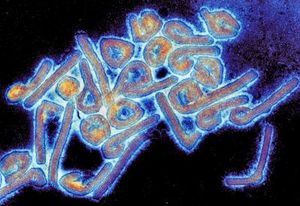Evolution of Dolphins: Difference between revisions
(Created page with "==Introduction== Select a topic about genetics or evolution in a specific organism or ecosystem.<br> The topic must include one section about microbes (bacteria, viruses, fung...") |
|||
| Line 1: | Line 1: | ||
==Introduction== | ==Introduction== | ||
The evolution of dolphins, or <i>Delphinus</i>, is believed to have started with the <i>Pakiectus</i> a four legged, land walking mammal. The <i>Pakiectus</i> dates back to approximately 50 million years ago. Throughout the centuries, these animals have gone through drastic changes to become the modern day dolphin. Along with the <i>Pakiectus</i>, the dolphin is thought to have evolved alongside or from the <i>Ambulocetus</i>, <i>Protocetid</i>, <i>Dorudontid</i>, <i>Squalodontidae</i>, <i>Aetiocetidae</i>, and <i>Kentriodontidae</i> to eventually become the <i>Delphinus</i>.<ref>[https://dolphin-academy.com/learn/evolution]</ref> The Pakiectus lived near the shallow waters and began to feed on organisms that lived in these waters, which began the transition from terrestrial to aquatic animals. The bone structure of the flipper in the modern dolphin is very similar to the structure found in the Pakiectus legs and hooves, confirming the link between the two organisms.<ref>[https://www.dolphins-world.com/dolphin-evolution/]</ref> | |||
< | Physical connections <ref>[https://www.dolphins-world.com/dolphin-evolution/]</ref> | ||
[[Image:marburgvirus.jpg|thumb|300px|right|Colony of Marburg virus. Transmission electron microscope image taken by Dr. Tom Geisbert]] | [[Image:marburgvirus.jpg|thumb|300px|right|Colony of Marburg virus. Transmission electron microscope image taken by Dr. Tom Geisbert]] | ||
Revision as of 03:52, 28 October 2019
Introduction
The evolution of dolphins, or Delphinus, is believed to have started with the Pakiectus a four legged, land walking mammal. The Pakiectus dates back to approximately 50 million years ago. Throughout the centuries, these animals have gone through drastic changes to become the modern day dolphin. Along with the Pakiectus, the dolphin is thought to have evolved alongside or from the Ambulocetus, Protocetid, Dorudontid, Squalodontidae, Aetiocetidae, and Kentriodontidae to eventually become the Delphinus.[1] The Pakiectus lived near the shallow waters and began to feed on organisms that lived in these waters, which began the transition from terrestrial to aquatic animals. The bone structure of the flipper in the modern dolphin is very similar to the structure found in the Pakiectus legs and hooves, confirming the link between the two organisms.[2]
Physical connections [3]
At right is a sample image insertion. It works for any image uploaded anywhere to MicrobeWiki. The insertion code consists of:
Double brackets: [[
Filename: PHIL_1181_lores.jpg
Thumbnail status: |thumb|
Pixel size: |300px|
Placement on page: |right|
Legend/credit: Electron micrograph of the Ebola Zaire virus. This was the first photo ever taken of the virus, on 10/13/1976. By Dr. F.A. Murphy, now at U.C. Davis, then at the CDC.
Closed double brackets: ]]
Other examples:
Bold
Italic
Subscript: H2O
Superscript: Fe3+
Section 1 Genetics
Include some current research, with at least one image.
Sample citations: [4]
[5]
A citation code consists of a hyperlinked reference within "ref" begin and end codes.
Section 2 Microbiome
Include some current research, with a second image.
Conclusion
Overall text length should be at least 1,000 words (before counting references), with at least 2 images. Include at least 5 references under Reference section.
References
Edited by [Author Name], student of Joan Slonczewski for BIOL 116 Information in Living Systems, 2019, Kenyon College.

